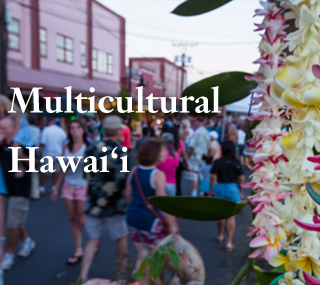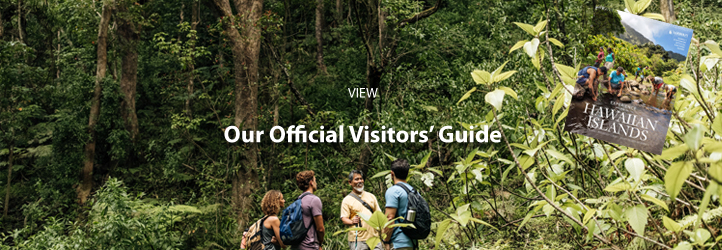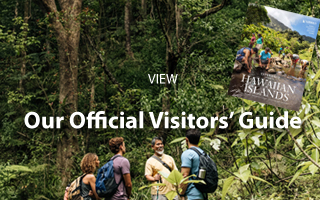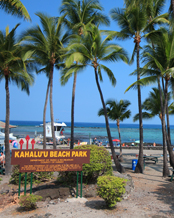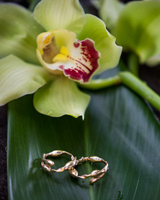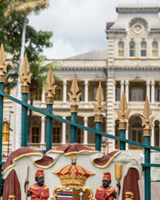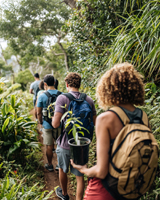 |
Discovering Hawai‘i's Multiculturalism
Hawaiʻi’s rich multicultural tapestry isn’t just about embracing traditions from various ethnicities, but also encompasses the widespread practice of aloha by its residents. The world witnessed such unequivocal aloha as communities came together following the devastating wildfires on Maui.
Although Lahaina remains closed, respectful travel to the accessible areas of Maui—and any of the Hawaiian Islands—is welcomed, especially as West Maui accommodations have begun reopening to visitors earlier this month. Your client’s visit will play a crucial role in supporting Hawaiʻi’s businesses and the livelihoods of its workers, who depend on tourism to sustain their families, especially when approached with mindfulness.
Kaua‘i
If you have clients visiting Kauaʻi, encourage them to check out the Kaua‘i Museum, home to captivating historical collections from Kauaʻi and Niʻihau artisans, as well as galleries featuring the works of multicultural artists, sculptors and craftsmen. The historic, lava rock-constructed Līhuʻe town museum also offers visitors insights on the geological history of the Hawaiian Islands, early settlement of the Islands by Polynesian voyagers, Captain James Cook’s 1778 docking in Waimea on Kaua‘i’s west side, and the Hawaiian monarchy.
O‘ahu
On O‘ahu, clients can enjoy a captivating journey back to the early 1900s sugar- and pineapple-plantation era and the lives of its laborers of many cultures at Hawaii Plantation Village. Located in the former sugar-plantation town of Waipahu, the plantation-village reimagining presents more than 25 recreations and restorations of plantation homes and structures visitors are invited to walk through and explore, each including personal artifacts, clothing, furniture and art. Tours are self-guided or led by local guides with knowledge of Hawai‘i’s plantation history.
Lānaʻi
On Lānaʻi, the historic Lānaʻi City welcomes your clients to uncover the rich significance behind the plantation town. During the 1900s, Lānaʻi was the center of the island’s booming pineapple industry, responsible for 75 percent of the world’s pineapple production. As clients walk through the city with the Lānaʻi Guide App (currently available for iPhone only), they can witness and learn more about the great history and culture behind the various landmarks. Along the way, clients can also take a stop at the Lānaʻi Culture & Heritage Center. This community museum represents the largest archive of Lānaʻi-focused materials that range from traditional artifacts to historic plantation objects. Guests can also participate in different events and programs that are geared to inspire people to be informed, thoughtful and active stewards of Lānaʻi’s legacy landscape.
Island of Hawai‘i
Have clients visiting the island of Hawai‘i in early November? Suggest they check out the events of the annual Kona Coffee Cultural Festival, one of the state’s longest-running food festivals. The 10-day celebration honors the district’s past and present coffee farmers, planters, pickers, roasters and crop scientists of many cultures, as well as the culture, history, artisans and residents of Kona’s world-famous coffee-growing communities. The festival’s many events include coffee tastings, cupping competitions judging Kona’s best coffee, farm and mill tours, coffee art exhibits, an evening lantern parade through historic Kailua-Kona, food events and more. Clients can learn more about the historical and cultural roots of the island of Hawai‘i’s sugar plantation era at the Hawai‘i Plantation Museum in Pāpa‘ikou, just north of Hilo. Visitors to the museum are treated to a fascinating glimpse of the lives of the island’s plantation laborers from the mid-1800s through 1990s via artifacts, photographs and historic records sharing how the sugar industry was a major factor in Hawai‘i’s present-day community of multiple cultures.
|
 |



